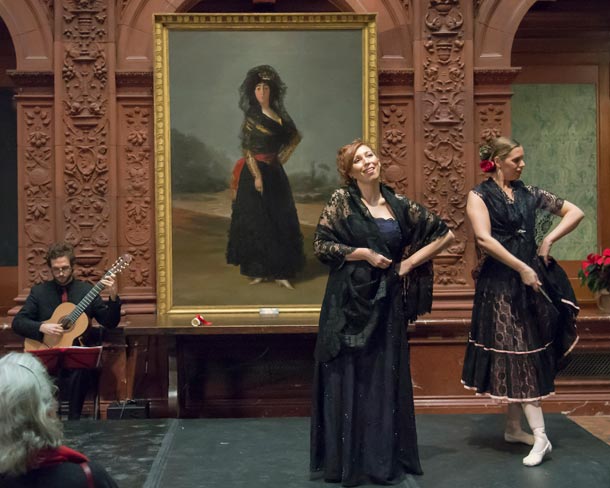A Lady of Spain
December 14, 2012
by Keith Widyolar
Last night the Hispanic Society of America, the museum with the most important collection of classical Spanish art outside of Spain, hosted a delightful presentation of “Music and Dance in the time of the Duchess of Alba (1762-1802).” The performance was followed by a reception in the magnificent Sorolla gallery where diplomatic, business and cultural leaders of New York’s Spanish community mixed and mingled in the warm light of Sorolla’s massive mural about rural life in each of the nations of Spain.
From a stage in front of the museum’s most famous work of art, a storied Goya portrait of the Duchess of Alba, mezzo soprano Anna Tonna sang historic tales about the Duchess to the accompaniment of Rupert Boyd on Spanish guitar while dancer Anna de la Paz performed boleros of the period. The performance turned out to be a clever biography of the Duchess herself who coyly watched the proceedings without saying a word.
Music and Dance in the time of the Duchess of Alba ~ Rupert Boyd, the Duchess of Alba, Anna Tonna & Anna de la Paz
After a welcome by museum director Dr. Mitchell Codding, senior curator Dr. Marcus Burke explained a little about the lady and the painting. One of the highest ranking, most beautiful and most charismatic Spanish women of her day, Goya painted the Duchess in a black dress of mourning. She had retired to her Andalucian estate for the requisite year of mourning the death of her husband.
There she was joined by Goya who painted many portraits of her. This is said to be the last, a portrait filled with secret signs, two rings, a pointed finger, and words buried in the sand. No one knows for certain, but the Duchess was quite a precocious woman and it is widely suspected that their relationship was more than patron and artist.
Opera singer, Anna Tonna, held the audience captive with a voice that rang through the hall like a cinematic dream, a flirtatious glance in a train station that freezes the moment and stays in your mind.
“What Anna did today was sensational.”
Composer/Conductor Pablo Zinger
Anna de la Paz
Dancer Anna de la Paz entered the stage to the rustling accompaniment of the layers of her Spanish dress. She wore a shawl, not unlike that worn by the Duchess, but soon threw it off to the rolling clicks of castanets followed by a stampede of heels on wood. At times the guitarist and the dancer seemed to exchange roles, she playing the floor and he dancing on the strings.
All of these sensations and the furtive meanings in the painting were an unexpected surprise. Though the Duchess looks directly at you, she seems a bit stiff in the portraiture style of the day. The songs sung in Spanish, explained that she was anything but stiff. In fact she was the Spanish “It” girl of her time. Well aware of the effect of her beauty, she liked to play flirtatious games, sometimes even sneaking out of the court in disguise.
Knowing that a Spanish gentleman would never let a lady pay for her meal, she once sat with a man in a cafe and ordered everything on the menu. The poor fellow couldn’t pay and had to leave his trousers for security.
The Duchess was not fond of her Queen, probably the only lady in Spain with a rank higher than her own. Once after seeing a dress that the Queen would wear to the next palace event, the Duchess sent servants to Paris to buy four identical dresses and appeared at the event with four ladies in waiting dressed exactly like the star of the night, the Queen who hated her forever after.
Rupert Boyd
Looking at the painting, you cannot help but wonder why the Duchess is so resolutely pointing a finger to the ground at her feet. Goya was married, yet on the Duchess’ hand are two rings. One says “Alba” and the other says “Goya.” Her finger points at his signature in the sand. A 20th century cleaning revealed a hidden word, “Solo,” “Solo Goya” (only Goya).
Why “Only Goya?” Why did Goya take the painting with him on his departure from Andalucia? Why did he paint over the word “Only?” Why did he keep the picture with him until his death? A souvenir certainly, but of what?
“The artists have their own language.”
Juan Ramón Martínez Salazar
Consul General of Spain
The Duchess knows, but she doesn’t tell. It seems strange that in a time of smart phones and iPads, iTunes and YouTube, anyone would care enough to study what happened so long ago and far away. But if you visit the museum to see the “Black Duchess,” you too may fall under the spell of a lady of Spain.
The museum is open Tuesday-Saturday 10am-4:30pm and Sunday from 1-4pm.
This is the first in the museum’s 2012-2013 concert series.

